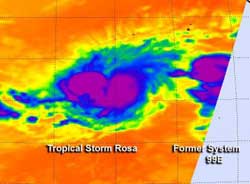NASA sees Tropical Storm Rosa's rains southeast of center

On Nov. 1, 2012 at 5:29 a.m. EDT the AIRS instrument aboard NASA's Aqua satellite took an infrared picture of Tropical Storm Rosa (left) and System 99E (right). The bulk of Rosa's rainfall was southwest of the storm's center.<br><br>Credit: NASA JPL, Ed Olsen<br>
When NASA's Aqua satellite flew over Tropical Storm Rosa at 5:41 a.m. EDT (0951 UTC) on Nov. 1, 2012 the Atmospheric Infrared Sounder (AIRS) instrument took an infrared picture of Tropical Storm Rosa and remnants of System 99E. The AIRS data showed the strongest convection (rising air that forms thunderstorms that make up a tropical cyclone) has been pushed southeast of Rosa's center as a result of northwesterly wind shear.
The convection in that quadrant was strong because the air pushed cloud tops of those thunderstorms to the top of the troposphere where temperatures are as cold as or colder than -63 Fahrenheit (-52 Celsius). Those are also areas where heavy rain typically falls. AIRS data showed that Rosa had become more disorganized, and that the banding of thunderstorms around the center was not as well-defined.
At 11 a.m. EDT Nov. 1, the center of Tropical Storm Rosa was located near latitude 13.9 north and longitude 118.4 west, about 825 miles (1,345 km) southwest of Cabo San Lucas, Mexico. Rosa had maximum sustained winds near 50 mph (85 kph) and was moving toward the west-southwest near 2 mph (4 kph). Rosa is expected to drift to the southwest and weaken over the next couple of days.
The low pressure area called System 99E that lies east of Rosa was also affected by wind shear and is no longer suspect for tropical development.
Media Contact
More Information:
http://www.nasa.govAll latest news from the category: Earth Sciences
Earth Sciences (also referred to as Geosciences), which deals with basic issues surrounding our planet, plays a vital role in the area of energy and raw materials supply.
Earth Sciences comprises subjects such as geology, geography, geological informatics, paleontology, mineralogy, petrography, crystallography, geophysics, geodesy, glaciology, cartography, photogrammetry, meteorology and seismology, early-warning systems, earthquake research and polar research.
Newest articles

A universal framework for spatial biology
SpatialData is a freely accessible tool to unify and integrate data from different omics technologies accounting for spatial information, which can provide holistic insights into health and disease. Biological processes…

How complex biological processes arise
A $20 million grant from the U.S. National Science Foundation (NSF) will support the establishment and operation of the National Synthesis Center for Emergence in the Molecular and Cellular Sciences (NCEMS) at…

Airborne single-photon lidar system achieves high-resolution 3D imaging
Compact, low-power system opens doors for photon-efficient drone and satellite-based environmental monitoring and mapping. Researchers have developed a compact and lightweight single-photon airborne lidar system that can acquire high-resolution 3D…





















